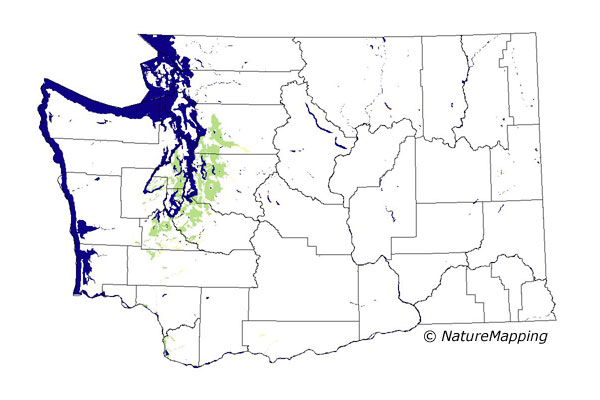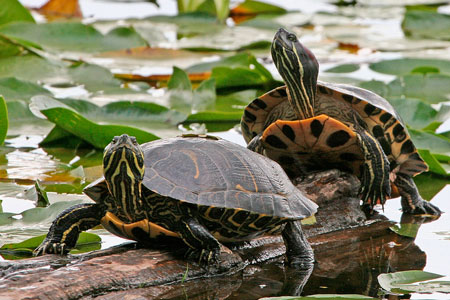


Red-eared Slider (Trachemys scripta elegans) What they look like: Red-eared Sliders are brightly marked, and look a lot like the Western Painted turtles. One difference between the two is it's top shell (carapace - prounounced CARE-a-pace). The Red-eared Slider's carapace looks like a bowl turned upside down while the Painted turtle is flatter. [ see comparison guide ] There are other distinguishing marks. The shell is divided into "scutes" - they look like separate plates stuck together to form the shell. The scutes along the outside edge of the carapace are outlined in yellow. There is alos red ear mark located just behind the eye. The head, neck, and legs are greenish with yellow stripes. The plastron (bottom shell) is yellow with a dark, rounded blotch in each scute.
Males are slightly smaller than females and have longer claws on their front feet. Old turtles, especially males,
may become very dark and almost look black all over 
Range/ Habitat: The introduced Red-eared Slider likes to live where the Western Painted Turtle lives so it important to look for the different marks to identify the turtles. Red-eared Sliders are one of the most common turtles in the Puget Sound area. They can be found basking in the sun around Lake Washington and ponds in Western Washington. This turtle lives in ponds, lakes, marshes, and in slow-moving rivers that have soft, muddy bottoms. Pond sliders are native in the southern Great Lakes region east to West Virginia, west to Indiana and Illinois and south throughout most of the southeastern and south-central United States. The red-eared slider turtles common in the pet trade so they are turning up all around the globe. They are now considered among the word's 100 most invasive species because people get tired of them and release them into the wild (The Humane Society). Click the map for information about the habitat and range of the Pond Sliders (Trachemys scripta) in Washington. Diet: Red-eared Sliders feed mainly on plants and small animals, such as crickets, fish, crayfish, snails, tadpoles, worms, aquatic insects and aquatic plants. Turtles don't have teeth, but instead have horny ridges that have little sharp groves, like a serrated knife on their upper and lower jaws. Reproduction: The breeding season lasts from late spring to early summer. Courtship and mating usually takes place between March and July, and take place underwater! Females make their nest on land in soft, sandy soil with lots of sunlight to keep their nest warm. Nests are dug with the turtle's hind feet, usually within 200 meters of water. The nest is no deeper than 10 to 12 centimeters. The females will lay 2 to 30 oval, soft shelled eggs. The eggs are fertilized as they are being laid and buried in the sand. Development: A baby turtle will become a boy or girl depending on the temperature within the nest. Pond slider eggs that are incubated at temperatures between 22 and 27 degrees Celsius become only males, while eggs that are incubated at warmer temperatures become females. Baby sliders hatch out of the egg looking like small adults. Behavior: Raccoons, otters, mink, foxes, and other medium-sized animals will eat turtles and their eggs. Turtles keep a watch out for predators and slide into the water at the first sign of danger. They can quickly pull their head and legs into their hard shell if they can't get into the water. Red-eared Sliders like to lay in the sun in groups. They like logs, fallen trees, and other objects near water (see photo). The warm sun helps rid them of parasites. Reptiles do not hibernate but become less active during the winter. Red-eared sliders spend the winter at the bottom of ponds or shallow lakes. They become inactive, generally, in October, when temperatures fall below 50 °F (10 °C).
Did you know?
Definitions: carapace - a turtle's top shell keel - a raised ridge along the middle (front to back) of the carapace of some turtles plastron - a turtle's bottom shell scute - the large, separate scales on the carapace and plastron of most turtles
More Information: Thinking of Getting a Pet Turtle? Red-eared Slider - Animal Diversity Web Painted Turtle - Animal Diversity Web Painted Turtle Facts - NatureMapping Animal silhouettes available to purchase » Photos: Alan Wilson Home | About Us | How to Participate | Biodiversity Modules | Projects | Maps | News | Resources |